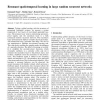141 search results - page 22 / 29 » Expression Learning and Recognition System for a Family Robo... |
BC
2002
13 years 7 months ago
2002
Taking a global analogy with the structure of perceptual biological systems, we present a system composed of two layers of real-valued sigmoidal neurons. The primary layer receives...
MLMTA
2007
13 years 9 months ago
2007
- While grammar inference (or grammar induction) has found extensive application in the areas of robotics, computational biology, speech and pattern recognition, its application to...
ATAL
2007
Springer
14 years 1 months ago
2007
Springer
Activity recognition is a key component for creating intelligent, multi-agent systems. Intrinsically, activity recognition is a temporal classification problem. In this paper, we...
ICRA
2009
IEEE
14 years 2 months ago
2009
IEEE
— In this paper we present a novel methodology for detection and tracking of facial features like eyes, nose and mouth in image sequences. The proposed methodology is intended to...
ICARCV
2006
IEEE
14 years 1 months ago
2006
IEEE
— As confirmed by recent neurophysiological studies, the use of dynamic information is extremely important for humans in visual perception of biological forms and motion. Apart ...

